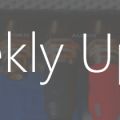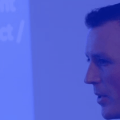I talk to Dona Sarkar about Power Platform, Accessibility & Development
At South Coast Summit 2021, I had the opportunity to talk to Dona Sarkar, Director of Technology – Accessibility at Microsoft. She was there as a keynote speaker and hackathon judge, and I couldn’t pass up the opportunity to ask her about her new role at Microsoft.
This was such a fun interview to do and very informative for me as well: for instance, I had never really thought about accessibility as a SEO tool. Thanks so much to Dona for being so gracious with her time.
By the way, if you want to know what South Coast Summit was like my Day 1 video is out now.
Transcript
Tom: Hello. I’m Tom Morgan, Microsoft MVP, I’m at South Coast Summit, and I’m with the fantastic Dona Sarkar.
Dona: Hello, everyone. Not fantastic, but I am here.
Tom: You’re pretty fantastic. So, I mean, you’ve just had a, you’ve done lots and lots of things.
Dona: Yes.
Tom: So you’ve come from the Windows Insider Program. You’ve done, you know, Dev Manager of Advocacy, Power Platform, and now you are Director of Technology, Microsoft Accessibility, but you’re here, you’re at the Power Platform hack. So in my mind, like you go to Director of IT, you go to the top floor and you kind of check out all the technical stuff, but you’re here at hackathon.
Dona: Oh no, no. I think for me at heart, I’m a Dev right. And I have to see what other Devs are doing. And like, you know, micromanaging needle. Also, accessibility is a topic that impacts every single product, not just at Microsoft, but actually in the world, because you actually have no idea. People from all different backgrounds using your tech, what else they need. Right. So it really helps me to watch people building products and services and concepts and to figure out like, okay, what would it mean to have someone who’s deaf use this? What would it mean to have someone who is blind use this or someone dyslexic like me? So accessibility touches all of us. And I am here among to do many things, but to focus on how accessibility should be mainstream, it should be a topic we all concerned ourself with because it actually concerns all of us.
Tom: And we see, we see some of that in Microsoft. We see some of that come into products, but I mean, within Microsoft, but also I guess, with outside of Microsoft, for developers, like what’s… do we have a long way to go; a little way to go?
Dona: We’ve made a lot of progress, right? We made a ton of progress, but the journey is, it’s not like, oh, you’re going to reach a point and you’re done. It’s we learn more every day. And two of the topics, I’m here to talk a lot about are neurodiversity and mental health. So these are two things that people in my generation were not diagnosed with until much later in life, because we didn’t talk about it. Now people with ADHD, people with dyslexia are getting diagnosed in their thirties and forties, because we just know to test for them. And often it’s because their kids got diagnosed and the neurologists are like, let’s test your parents. And it turns out parents, you weren’t bad at school, you just happen to be dyslexic. So I learned, I was dyslexic when I was 31 years old, that is not normal. Right. And the other topic is mental health. And I will talk a lot about this tomorrow at the keynote, but there is none of us in this entire building probably in this entire city, this entire country that have not been touched by mental health in the last 18 months, every single last person has had a sense of anxiety, of sense of depression or someone in our house has. And these are all accessibility topics. And it’s something that we in the tech industry should be just conscious of when we build products.
Tom: Are there things that, is that like a checklist for developers to go to be thinking about? Because I think there’s a lot of, like, if you go and ask about it, then there’s a lot of, oh, of course, but actually it’s not in their heads. It’s not front of their minds when they’re building stuff.
Dona: I’m really glad you asked that because I realized I didn’t learn about accessibility when I was studying computer science. I don’t, I didn’t learn about accessibility. My first 10 years of being a developer, right. I only learned like 10 years into career, which is weird, but some basic things that developers can do run accessibility insights, it’s accessibilityinsights.io on anything, any website you build, because I’ll give you all of the top issues. It’s a free tool. It’s open source with Microsoft and a bunch of other partners. That’s a basic thing. They also have a checker for Android apps. So if you’re building an Android app or a website go check. Second thing is just put a way to have alt text on images, right? There’s many ways to do it, but image descriptions and alt texts are really, really important. And the third put captions on your videos. If you’re making videos or making a video platform, make adding captions easy, it’s really good for folks who are deaf folks who speak another language. And for SEO, like no one thinks about SEO, but putting captions on video, actually make your videos maybe a hundred thousand times more percent discoverable. I did all these tests myself because I’m a dev and I don’t believe anything. So it’s actually true when you’re more accessible, you actually have more impact with everybody.
Tom: That’s really cool. That’s really, I never thought about that either. Like I’m a developer. I also do these videos. I never even thought about that. Of course having a caption file makes it easy for a bot to read it. All right.
Dona: It just makes it easier. So have a transcript file, have a caption file because really your SEO will go up.
Tom: Really interesting.
Dona: Yeah.
Tom: And you’ve been very open about your dyslexia. For young people, for people wanting to come into this industry. What would you say to them? Like you were an example of that being done. I mean, what was that journey like?
Dona: I’ll tell you, I actually think computer science or technology is a wonderful industry for those with dyslexia because the compiler will tell you when you’re wrong. It’s one of the reasons I, you know, I am a writer, I’m an author and all these things. And I struggle with, I struggled much more with the arts than I do with computer science and being dyslexic, you actually gained a bunch of really interesting superpowers. Like you’re weirdly good at 3D visualization. You’re really good at understanding spatial things. So I was telling them one of my favourite products at Microsoft that I worked on was the Holo Lens mixed reality. I was really, really good at it. People are like, how are you naturally kind of good at 3D visualization and all of this? I don’t know, it’s a mystery, so odd. Now I realize, oh, because this girl is dyslexic. So if you are dyslexic, join tech. There’s a lot of us here a lot. I bet if I go in that room and say, how many of your dyslexic you’re going to have? Like, I don’t know, a third of people raise their hand, it’s a very good industry. It’s an industry where you can openly talk about it cause we’re building tech solutions to help. Right? So I think it’s a wonderful field, better than trying to be a dyslexic lawyer. That’s learn, memorize and learn, memorize. Or a doctor. Like you can do it, but I can see them as being infinitely harder than being in tech.
Tom: If the technology was just not an object, you could make anything possible. What would you do?
Dona: I think what I would do is figure out how accessibility can be part of the system where I write a line of code. How can I make sure that that line of code is accessible toward people who are blind people who are deaf people with limited mobility, but also those who have mental health concerns, right? How do I make sure we’re doing no harm as we build the next generation of products? That’s what I would do. Wave my magic wand.
Tom: And final question because I was, I was showing your resume to one of my colleagues and I was kind of like, what should I ask Dona? And she read it through, sheen the stuff you’ve been doing at Microsoft, your fashion company, your side hustlesâ¦question was, do you sleep?
Dona: I do. I’m a really good sleeper. I think the key is to draw some really hard boundaries around your day and say like, I am going to work on this from this hour to that hour, this from this hour to that hour. And then I’m going to bed. I only do two things a day. And one of those things is mental health. So day job, mental health stuff, fashion design and mental health stuff. But that is the way to be in the game for a long time. Cause I plan to stick around this industry for like, I don’t know, a hundred years, that’s a lot of trouble to cause. Right. So yeah, that’s the plan.
Tom: Fantastic, thanks very much.
Dona: Thank you








